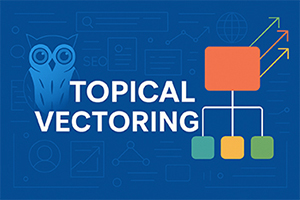Topical Vectoring
 In the ever-evolving landscape of SEO, understanding how to comprehensively cover a subject has become more critical than ever. Traditionally, the concept of topical clusters helped marketers organize content around a central theme, improving relevance and authority. However, as search engines become more sophisticated, especially with AI-driven understanding, there is a new approach emerging: Topical Vectoring.
In the ever-evolving landscape of SEO, understanding how to comprehensively cover a subject has become more critical than ever. Traditionally, the concept of topical clusters helped marketers organize content around a central theme, improving relevance and authority. However, as search engines become more sophisticated, especially with AI-driven understanding, there is a new approach emerging: Topical Vectoring.
What is Topical Vectoring?
Topical Vectoring builds upon the foundation of topical clusters but goes further by strategically addressing the full spectrum of user questions, contexts, and related themes in a cohesive, multidimensional manner. Instead of simply grouping related content, topical vectoring considers the nuanced relationships between subtopics and how they collectively guide search engines and users through a deeply interconnected knowledge space.
More importantly, topical vectoring is not just about having a bunch of pages loosely related to a single topic. It requires a hierarchical URL structure that reflects the logical organization of content. Flat site architecture no longer suffices if you want to win in modern search rankings. Internal linking must be deliberate and strategic, not random or superficial, to build clear pathways for both users and AI-powered search engines. Simply slapping links together won’t cut it. To succeed, you need to learn how to implement topical vectoring properly.
Why Topical Vectoring Matters
As AI and language models increasingly drive search results, the importance of presenting content that spans both depth and breadth of a topic cannot be overstated. Topical vectoring ensures that your content is not just a collection of related articles but a strategically crafted ecosystem that signals expertise, relevance, and trustworthiness.
In the coming pages, we will explore how to implement topical vectoring effectively, with practical guides, examples, and tools to elevate your SEO strategy to meet the demands of modern search engines.
Clusters vs. Vectors:
Many SEO professionals are familiar with the concept of topic clusters, but topical vectors take this strategy to a deeper level by focusing on the connections & context between ideas, not just grouping related pages. If you want to understand the crucial differences, and why vectors matter more in the AI era—read our detailed guide on Clusters vs. Vectors.
Single Page Topical Vectoring:
All topical vectoring begins with a single page. That one page, needs to be structured according to the same overall principles as would be applied to a section of the site, across sections of the site, and ideally on pages your brand is present on other high quality, highly relevant sites. Read our how-to guide on Single Page Topical Vectoring.
Sectional Topical Vectors:
Unlike old-school “hub and spoke” or “topic funnel” type sectional grouping, advanced sectional topical vectoring is more refined, more nuanced, and much better positioned to support today’s human, search engine and LLM needs. It’s a cohesive web of signals, chunking and signal reinforcement. Read our how-to guide on Sectional Topical Vectors.
Cross Sectional Topical Vectoring
Internal linking is an invaluable method for helping human visitors, search engines & LLMs, topical relationship understanding. This can be extended when there is a chunk or section within one section of a single page in one topical vector group, where you can link out of that group and into another topical vector group. Read our how-to guide on how to implement Cross Sectional Topical Vectoring.
Breaking the Sectional Topical Model
Sometimes, breaking some of the rules, is entirely vald. For a business with a few services distinct enough from each other, you may be better served having each service be a main site navigation link. Sometimes, just one page is enough for topical signal strength around a single topic compared to having a main services page and individual service details pages below that. Read our how-to guide on Breaking the Sectional Topical Model.
Implementing Sectional Navigation
If you want to truly maximize usability for humans, search engines, and LLMs, you need to provide advanced navigational features on your site. These can significantly reinforce topical understanding, topical depth and topical vectoring. Read our how-to guide on Implementing Sectional Navigation.
About The Author
Veteran SEO consultant since 2000, author of the QUART SEO+AI Framework, specializing in forensic site audits since 2006.
Industry speaker at conferences across the US.
Notable Clients include NBC/Universal, Disney, FTD.com, ProFlowers.com, Liberty Mutual Insurance, Union Bank, ACLU, Wired.com
